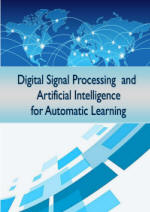| Research project: Architecture of Neural networks for arrhythmia detection | |
| << TO BE UPDATED, PLEASE VISIT AGAIN>> | |
| This project describes the development of a detection system for the QRS complexity present in the electrocardiogram. The capture of electrocardiogram signal was achieved through electrodes with the help of an acquisition card. On the part of the signal processing and the graphical user interface were made by programming in Python. The technique used to detect the R peaks was the use of the Hilbert transform and adaptive thresholds [2]. | |
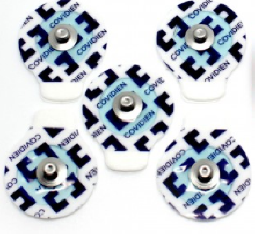 |
 |
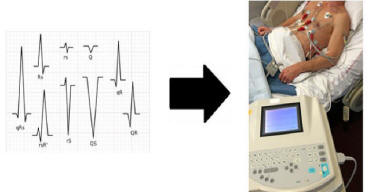 |
The QRS complex is of
great importance for the diagnosis of
cardiac anomalies, which
is why new algorithms and
mathematical models are
sought for its detection. In addition, the monitoring of the
ECG signal in people who
present these problems, through conventional
electrocardiograms, is limited because the person is
wired to the device and
lacks portability, preventing information from being
obtained when the person is doing
daily activities. |
| ECG monitoring [2] | |
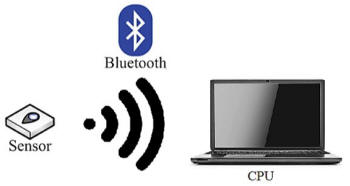 |
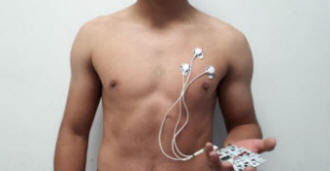 |
| data acquisition via Bluetooth [2] | Triangular placement of electrodes [2] |
|
Bsc. Thesis Student:Isaac De León Damas 131884 [1] |
|
 |
This project presents a data
acquisition system for the R peak detection in
electrocardiograms. R wave is one of the most important
sections of the QRS complex, which has an essential role in
diagnosis of heart rhythm irregularities. This paper employs
Hilbert transform
and
adaptive threshold technique
for the detection of R peak. The performance of the system was tested using standard ECG waveform records from the MIT-BIH arrhythmia database. In addition, tests were carried out using the sensors for real-time data processing [2]. |
|
Bsc. Thesis Student: Gabriela Idali Ibarra. 120730 [2] |
|
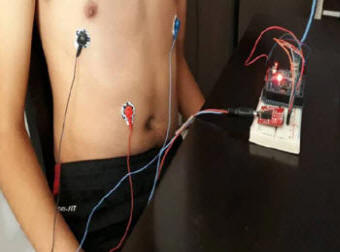 |
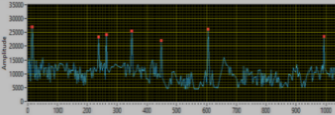 |
|
Bsc. Thesis Student:Valeria Vargas Morales 120819[3] |
|
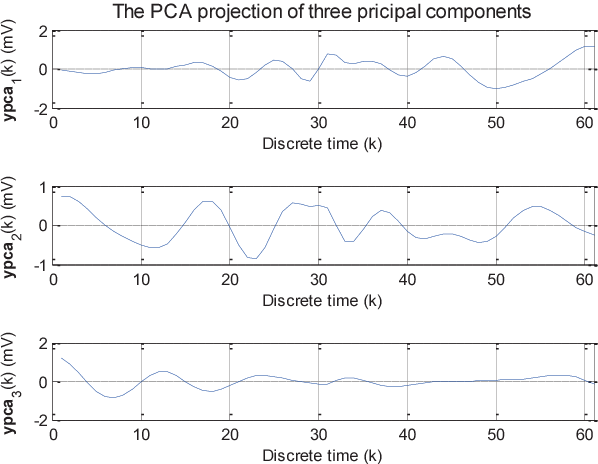 |
|
| First three principal components [1] | |
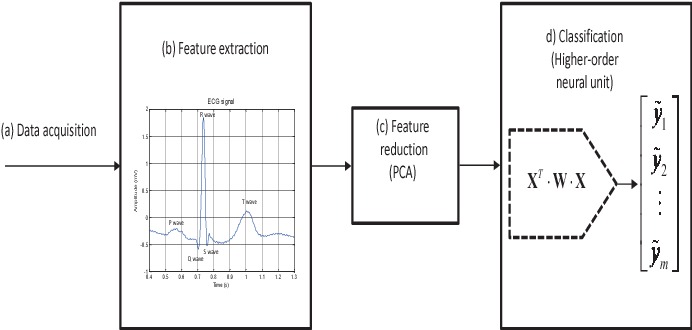 |
|
| Diagram of the methodology for ECG arrhythmia classification [1] | |
| Publications: | |
| Research papers: | |
| [1] Ricardo Rodriguez, Osslan O. Vergara, Vianey G. Cruz, Adriana Mexicano, “Arrhythmia disease classification using a higher-order neural unit,” Fourth International Conference on Future Generation Communication Technologies (FGCT 2015, July 29-31, 2015. (Indexed by IEEE Xplore). | |
| [2] Ricardo Rodriguez, Adriana Mexicano, Jiri Bila, N. B. Nghien, Rafael Ponce, Salvador Cervantes,“ Hilbert- Huang Transform and Neural Networks for Electrocardiogram Modeling and Prediction,” The 2014 10th International Conference on Natural Computation (ICNC 2014), August 19-21, 2014, Xiamen, China. (Indexed by Core-Rank). | |
| [3] Ricardo Rodriguez, Adriana Mexicano, Jiri Bila, Rafael Ponce-Medellin, Salvador Cervantes, “Adaptive Threshold and Principal Component Analysis for Feature Extraction of Electrocardiogram Signals, ” International Symposium on Computer, Consumer and Control 2014, IEEE Computer Society Washington, DC, USA 2014, June 10-12, 2014 Taichung, Taiwan.(Indexed by IEEE Xplore). | |
| [4] Ricardo Rodriguez, Adriana Mexicano, Salvador Cervantes, Jiri Bila, Rafael Ponce, “Extracting the QRS complexity and R beats in electrocardiogram signals using the Hilbert transform,” 2013 Interdisciplinary Symposium on Complex Systems, September, 10-13, 2013, Prague, Czech Republic. | |
| [5] Ricardo Rodriguez, Adriana Mexicano, Jiri Bila, Rafael Ponce, Salvador Cervantes, Alicia Martinez, “Hilbert Transform and Neural Networks for Identification and Modeling of the ECG Complex” Third International Conference on Innovative Computing Communication Technology, ISBN: 978-1-4799-0048-0, August 29-31, 2013, London, UK.(Indexed by IEEE Xplore). | |
| [6] Ricardo Rodriguez, Adriana Mexicano, Jiri Bila, S. Cervantes, and Rafael Ponce, “Feature Extraction of Electrocardiogram Signals by Applying Adaptive Threshold and Principal Component Analysis,” (Indexed in JCR, impact factor: 0.447). (Indexed by Scopus). | |
| [7] Ricardo Rodriguez, Adriana Mexicano, Jiri Bila, Rafael Ponce, Salvador Cervantes, “Electrocardiogram Complexity Recognition and Modeling by Multilayer Perceptron,” Progress in Signals and Telecommunication Engineering, Volume 2, Issue 2, September, 2013, pp. 61-72, ISSN: 2319-4588. | |
| Advised thesis: | |
| [1] Bachelor thesis: “Detection of the R peak in ECG signals obtained in real time by means of the single lead sensor,” by the student Valeria Vargas Morales, to get the title of Engineer in Mechatronics. Mechatronics Program. Autonomous University of Ciudad Juárez. Dec 2017. (Advisor: Dr. Ricardo Rodriguez Jorge). | |
| [2] Bachelor thesis: “Detection of QRS complexity in real time through Bluetooth communication,” by the student Isaac De Leon Damas, to get the title of Engineer in Mechatronics. Mechatronics Program. Autonomous University of Ciudad Juárez. Dec. 2018. (Advisor: Dr. Ricardo Rodriguez Jorge). | |
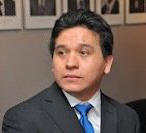 |
Ricardo Rodríguez Jorge, PhD Assistant Professor/Researcher Faculty of Science Department of Informatics Jan Evangelista Purkyně University Czech Republic Mechatronics, Signal Processing, Control and Artificial Neural Networks Research Interest Group |
Visiting Professor, Czech Technical University in Prague, Czech Republic (Dec 2016 -January 2017) Research visit, Tohoku University, Japan (May- Jul 2011) |
Contact Information: E-mail: ricardo.rodriguezjorge.mx@ieee.org Telephone: +420 475 286 724 Office: 6.07 (CPTO) Skype: rodriguezri |
| I welcome my colleagues and fellow academics to this web site. If you would like to discuss any of my published work, please feel free to contact me. My professional interests are mainly in Engineering and my work today has been focused on signal processing and machine learning to bridge innovative ways in these areas. | |||
| I am always looking for industrial and academic collaboration, please do not hesitate to contact me for project collaborations. For more information about my current running projects please visit Research projects. | |||
| Institute web page: https://ki.ujep.cz/cs/personalni-slozeni/ricardo-rodriguez-jorge/ | |||
